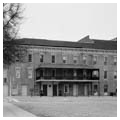In 1869, the Public Hall Association proposed a performance hall for the city of Columbus in western Georgia. For Francis Joseph Springer, an immigrant from Alsace and the principal investor and eventually full owner of the opera house that bears his name, this was an opportunity to bring a bit of old world civilization to the Chattahoochee River Valley. The theater, designed by Daniel Matthew Foley, occupied a three-story brick hotel on the northeast corner of First Avenue and Tenth Street. It opened on February 21, 1871, but gained even greater success following a 1900 expansion and remodel by theater specialist J. B. McElfatrick.
McElfatrick expanded the building eastward to accommodate a taller main stage, second balcony, and space for other sources of revenue such as hotel rooms, office space, and restaurants. The brick facade features evenly spaced windows with pressed metal lintels on the upper two stories and stone sills; a pressed metal cornice wraps around the building. A second-story veranda shelters the main entrance of the theater.
As early as 1915, Springer started showing motion pictures on a regular basis and the slow decline of theater began. The building remained a venue for both movies and live theater until the Depression, but by 1931 theater performances ceased, and the opera house tried to survive as movie house. The Springer closed entirely in 1958. Throughout its history, the Springer Opera House played host to major celebrities and theater personalities including Edwin Booth, Oscar Wilde, Ethel Barrymore, and Ma Rainey.
The Springer stood vacant for five years, and without a preservation program established in Columbus, it appeared the building would be demolished. Actors from the Columbus Little Theater and a group of civic leaders began a campaign to save the opera house, an event which is credited as spearheading a citywide historic preservation movement. A 1964 restoration included stabilizing the main auditorium, ground-floor spaces, and a portion of the second floor. The theater opened with live productions again in 1965. As it neared its centennial year, the opera house was listed on the National Register of Historic Places in 1970 and President Jimmy Carter named the building Georgia’s State Theater for its centennial. Seven years later the Springer Opera House was designated a National Historic Landmark.
In 1998–1999, a comprehensive historic renovation of the theater included the renovation of the decorative painting of the proscenium arch, an extensive use of Bradbury and Bradbury historic wallpapers, and the rediscovery of previously unknown painting designs on the underside of both balconies. The project also included doubling the space available to the theater and equipping the facility with state-of-the-art technology in lighting, sound engineering, rigging, technical support equipment, and new rehearsal and studio performance space. The 700-seat auditorium provides a main stage venue for a professional theater company as well as touring Broadway musicals and concerts; a studio space serves smaller scale productions and the children’s theater; and other areas made available by the expansion serve the Springer Theatre Academy, one of the country’s largest and most accomplished training schools for young actors.
The theater’s main auditorium remains one of the most splendid architectural theater interiors in the country. The “grand ole lady” among Southern theaters, the Springer Opera House once again displays her beauty, and one can only applaud the performance of the building itself on those occasions when, as a theatergoer, one has a “night on the town” in Edwardian Columbus.
References
Biggers, Mrs. James J. W. Jr. “Springer Opera House,” Muscogee County, Georgia. National Register of Historic Places Inventory–Nomination Form, 1970. National Park Service, U.S. Department of the Interior, Washington, D.C.




